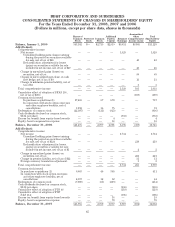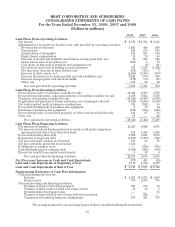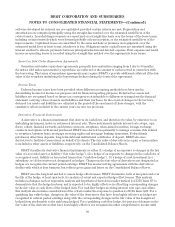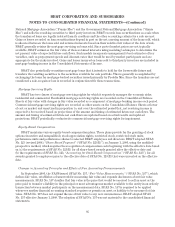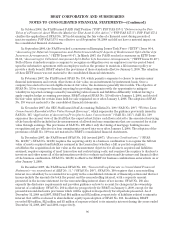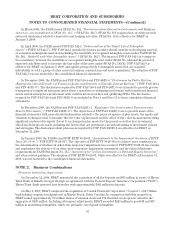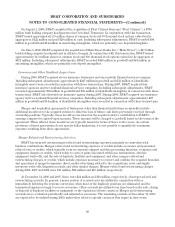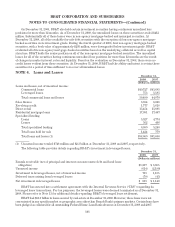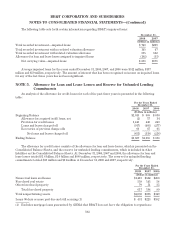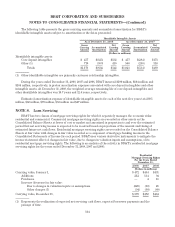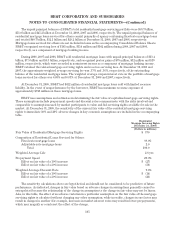BB&T 2008 Annual Report Download - page 95
Download and view the complete annual report
Please find page 95 of the 2008 BB&T annual report below. You can navigate through the pages in the report by either clicking on the pages listed below, or by using the keyword search tool below to find specific information within the annual report.BB&T CORPORATION AND SUBSIDIARIES
NOTES TO CONSOLIDATED FINANCIAL STATEMENTS—(Continued)
National Mortgage Association (“Fannie Mae”) and the Government National Mortgage Association (“Ginnie
Mae”) and sells the resulting securities to third party investors. BB&T records loan securitizations as a sale when
the transferred loans are legally isolated from its creditors and the other accounting criteria for a sale are met.
Gains or losses recorded on loan securitizations depend in part on the net carrying amount of the loans sold, which
is allocated between the loans sold and retained interests based on their relative fair values at the date of sale.
BB&T generally retains the mortgage servicing on loans sold. Since quoted market prices are not typically
available, BB&T estimates the fair value of these retained interests using modeling techniques to determine the
net present value of expected future cash flows. Such models incorporate management’s best estimates of key
variables, such as prepayment speeds and discount rates that would be used by market participants and are
appropriate for the risks involved. Gains and losses incurred on loans sold to third party investors are included in
mortgage banking income in the Consolidated Statements of Income.
BB&T also periodically securitizes mortgage loans that it intends to hold for the foreseeable future and
transfers the resulting securities to the securities available for sale portfolio. This is generally accomplished by
exchanging the loans for mortgage-backed securities issued primarily by Freddie Mac. Since the transfers are not
considered a sale, no gain or loss is recorded in conjunction with these transactions.
Mortgage Servicing Rights
BB&T has two classes of mortgage servicing rights for which it separately manages the economic risks:
residential and commercial. Residential mortgage servicing rights are recorded on the Consolidated Balance
Sheets at fair value with changes in fair value recorded as a component of mortgage banking income each period.
Commercial mortgage servicing rights are recorded as other assets on the Consolidated Balance Sheets at lower
of cost or market and amortized in proportion to, and over the estimated period that, net servicing income is
expected to be received based on projections of the amount and timing of estimated future net cash flows. The
amount and timing of estimated future net cash flows are updated based on actual results and updated
projections. BB&T periodically evaluates its commercial mortgage servicing rights for impairment.
Equity-Based Compensation
BB&T maintains various equity-based compensation plans. These plans provide for the granting of stock
options (incentive and nonqualified), stock appreciation rights, restricted stock, restricted stock units,
performance units and performance shares to selected BB&T employees and directors. BB&T adopted SFAS
No. 123 (revised 2004), “Share-Based Payment” (“SFAS No. 123(R)”), on January 1, 2006, using the modified-
prospective method, which requires the recognition of compensation costs beginning with the effective date based
on (a) the requirements of SFAS No. 123(R) for all share-based awards granted after the effective date and
(b) the requirements of SFAS No. 123, “Accounting for Stock-Based Compensation” (“SFAS No. 123”), for all
awards granted to employees prior to the effective date of SFAS No. 123(R) that were unvested on the effective
date.
Changes in Accounting Principles and Effects of New Accounting Pronouncements
In September 2006, the FASB issued SFAS No. 157, “Fair Value Measurements,” (“SFAS No. 157”), which
defines fair value, establishes a framework for measuring fair value and expands disclosures about fair value
measurements. SFAS No. 157 clarifies that fair value is the price that would be received to sell an asset or the
price paid to transfer a liability in the principal or most advantageous market available to the entity in an orderly
transaction between market participants on the measurement date. SFAS No. 157 is required to be applied
whenever another financial accounting standard requires or permits an asset or liability to be measured at fair
value. SFAS No. 157 does not expand the use of fair value to any new circumstances. BB&T adopted SFAS
No. 157 effective January 1, 2008. The adoption of SFAS No. 157 was not material to the consolidated financial
statements.
95


